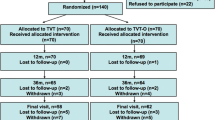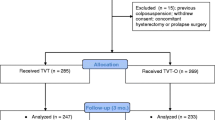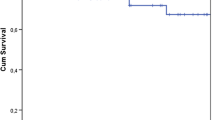Abstract
Introduction and hypothesis
The purpose of this study is to compare retropubic tension-free vaginal tape (TVT) with transobturator out-in TOT and in-out TVT-O for female stress urinary incontinence. Uroflow rate was primary; continence rates, quality of life (QoL) and complication pattern were secondary endpoints.
Methods
A prospective randomised trial with 2:1:1 randomisation at two Swiss teaching hospitals. Patients were followed up at 12 months.
Results
Eighty TVT, 40 transobturator tape (TOT) and 40 TVT-O were randomised. At 12 months, there was no difference in Qmax among the groups. Continence was comparable (≥89%). QoL was improved significantly in all groups (P < 0.05). Five vaginal tape exposures occurred (one TVT, four TOT, zero TVT-O; P = 0.028). Two percent (1/52) of sexually active patients after TVT, 17% (5/29) after TOT, but 0% (0/25) after TVT-O reported de novo female sexual dysfunction (P = 0.011). We considered this clinically important enough to stop enrolment.
Conclusions
There was no difference for Qmax at 12 months between TVT, TOT and TVT-O. Female sexual dysfunction and tape exposure may be higher with a transobturator tape.

Similar content being viewed by others
References
Ulmsten U, Petros P (1995) Intravaginal slingplasty (IVS): an ambulatory surgical procedure for treatment of female urinary incontinence. Scand J Urol Nephrol 29:75–82
Nilsson CG, Palva K, Rezapour M, Falconer C (2008) Eleven years prospective follow-up of the tension-free vaginal tape procedure for treatment of stress urinary incontinence. Int Urogynecol J Pelvic Floor Dysfunct 19:1043–1047
Novara G, Artibani W, Barber MD et al (2010) Updated systematic review and meta-analysis of the comparative data on colposuspensions, pubovaginal slings, and midurethral tapes in the surgical treatment of female stress urinary incontinence. Eur Urol 58:218–238
Latthe PM, Foon R, Toozs-Hobson P (2007) Transobturator and retropubic tape procedures in stress urinary incontinence: a systematic review and meta-analysis of effectiveness and complications. BJOG: Int J Obstet Gynaecol 114:522–531
Sung VW, Schleinitz MD, Rardin CR, Ward RM, Myers DL (2007) Comparison of retropubic vs transobturator approach to midurethral slings: a systematic review and meta-analysis. Am J Obstet Gynecol 197:3–11
Long C-Y, Hsu C-S, Wu M-P, Liu C-M, Wang T-N, Tsai E-M (2009) Comparison of tension-free vaginal tape and transobturator tape procedure for the treatment of stress urinary incontinence. Curr Opin Obstet Gynecol 21:342–347
Delorme E (2001) Transobturator urethral suspension: mini-invasive procedure in the treatment of stress urinary incontinence in women. Prog Urol 11:1306–1313
de Leval J (2003) Novel surgical technique for the treatment of female stress urinary incontinence: transobturator vaginal tape inside-out. Eur Urol 44:724–730
Richter HE, Albo ME, Zyczynski HM et al (2010) Retropubic versus transobturator midurethral slings for stress incontinence. N Engl J Med 362:2066–2076
Lukacz ES, Luber KM, Nager CW (2004) The effects of the tension-free vaginal tape on voiding function: a prospective evaluation. Int Urogynecol J Pelvic Floor Dysfunct 15:32–38
Costa P, Grise P, Droupy S et al (2004) Surgical treatment of female stress urinary incontinence with a trans-obturator-tape (T.O.T.S) UratapeS: short term results of a prospective multicentric study. Eur Urol 46:102–107
Bjelic-Radisic V, Dorfer M, Tamussino K, Greimel E (2005) Psychometric properties and validation of the German-language King’s Health Questionnaire in women with stress urinary incontinence. Neurourol Urodyn 24:63–68
Lukacz ES, Lawrence JM, Burchette RJ, Luber KM, Nager CW, Buckwalter JG (2004) The use of visual analog scale in urogynecologic research: a psychometric evaluation. Am J Obstet Gynecol 191:165–170
Tunn R, Schaer G, Peschers U et al (2005) Updated recommendations on ultrasonography in urogynecology. Int Urogynecol J Pelvic Floor Dysfunct 16:236–241
Kociszewski J, Rautenberg O, Perucchini D et al (2008) Tape functionality: sonographic tape characteristics and outcome after TVT incontinence surgery. Neurourol Urodyn 27:485–490
Basson R, Berman J, Burnett A et al (2000) Report of the international consensus development conference on female sexual dysfunction: definitions and classifications. J Urol 163:888–893
Brubaker L (2006) Editorial: partner dyspareunia (hispareunia). Int Urogynecol J Pelvic Floor Dysfunct 17:311
Delorme E, Droupy S, de Tayrac R, Delmas V (2004) Transobturator tape (Uratape): a new minimally-invasive procedure to treat female urinary incontinence. Eur Urol 45:203–207
Kaelin-Gambirasio I, Jacob S, Boulvain M, Dubuisson J-B, Dällenbach P (2009) Complications associated with transobturator sling procedures: analysis of 233 consecutive cases with a 27 months follow-up. BMC Women’s Health 9:28
Tamussino K, Hanzal E, Kölle D et al (2007) Transobturator tapes for stress urinary incontinence: results of the Austrian registry. Am J Obstet Gynecol 197:634.e1–634.e5
Daneshgari F, Kong W, Swartz M (2008) Complications of mid urethral slings: important outcomes for future clinical trials. J Urol 180:1890–1897
Klutke C, Siegel S, Carlin B, Paszkiewicz E, Kirkemo A, Klutke J (2001) Urinary retention after tension-free vaginal tape procedure: incidence and treatment. Urology 58:697–701
Latthe PM, Singh P, Foon R, Toozs-Hobson P (2010) Two routes of transobturator tape procedures in stress urinary incontinence: a meta-analysis with direct and indirect comparison of randomized trials. BJU Int 106:68–76
Betschart C, Scheiner D, Hess E, Seifert B, Fink D, Perucchini D (2011) Patient satisfaction after retropubic and transobturator slings: first assessment using the Incontinence Outcome Questionnaire (IOQ). Int Urogynecol J Pelvic Floor Dysfunct 22:805–812
Haylen BT, Freeman RM, Swift SE et al (2011) An International Urogynecological Association (IUGA)/International Continence Society (ICS) joint terminology and classification of the complications related directly to the insertion of prostheses (meshes, implants, tapes) and grafts in female pelvic floor surgery. Int Urogynecol J Pelvic Floor Dysfunct 22:3–15
Moalli PA, Papas N, Menefee S, Albo M, Meyn L, Abramowitch SD (2008) Tensile properties of five commonly used mid-urethral slings relative to the TVT. Int Urogynecol J Pelvic Floor Dysfunct 19:655–663
Ross S, Robert M, Swaby C et al (2009) Transobturator tape compared with tension-free vaginal tape for stress incontinence: a randomized controlled trial. Obstet Gynecol 114:1287–1294
Elzevier HW, Putter H, Delaere KPJ, Venema PL, Lycklama à Nijeholt AAB, Pelger RCM (2008) Female sexual function after surgery for stress urinary incontinence: transobturator suburethral tape vs. tension-free vaginal tape obturator. The J Sex Med 5:400–406
Achtari C, McKenzie BJ, Hiscock R et al (2006) Anatomical study of the obturator foramen and dorsal nerve of the clitoris and their relationship to minimally invasive slings. Int Urogynecol J Pelvic Floor Dysfunct 17:330–334
Blaivas JG, Groutz A (2000) Bladder outlet obstruction nomogram for women with lower urinary tract symptomatology. Neurourol Urodyn 19:553–564
Acknowledgements
None.
Conflicts of interest
None.
Funding
No funding received.
Author information
Authors and Affiliations
Corresponding author
Additional information
David Scheiner and Cornelia Betschart contributed equally to this study.
Rights and permissions
About this article
Cite this article
Scheiner, D.A., Betschart, C., Wiederkehr, S. et al. Twelve months effect on voiding function of retropubic compared with outside-in and inside-out transobturator midurethral slings. Int Urogynecol J 23, 197–206 (2012). https://doi.org/10.1007/s00192-011-1543-8
Received:
Accepted:
Published:
Issue Date:
DOI: https://doi.org/10.1007/s00192-011-1543-8




